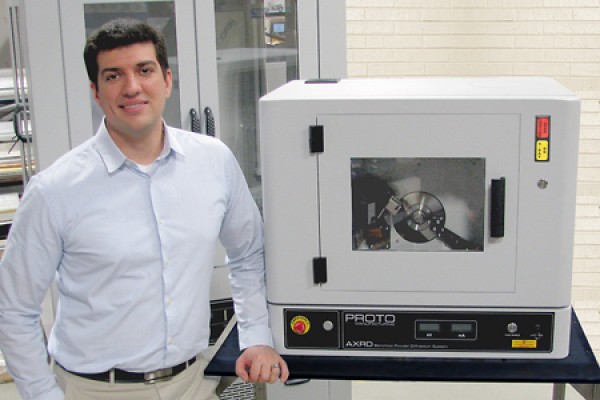 Nick Vukotic poses with PROTO Manufacturing’s new benchtop AXRD powder X-ray diffraction system, which takes up a fraction of the space of previous equipment. Photo credit: JCasey Media
Nick Vukotic poses with PROTO Manufacturing’s new benchtop AXRD powder X-ray diffraction system, which takes up a fraction of the space of previous equipment. Photo credit: JCasey Media
The purity of a pharmaceutical drug, the value of a mining sample, or the durability of construction concrete—a UWindsor post-doctoral fellow can tell you any of these, thanks to expertise in X-ray diffraction analysis he is applying in the real world.
Nick Vukotic, who earned his doctorate in the UWindsor Department of Chemistry and Biochemistry, is splitting his time between the University and PROTO Manufacturing, an Oldcastle-based X-ray diffraction systems and service company where he is developing new industrial applications for the technology.
“It’s fun to learn a technique that allows you to gain so much information,” Dr. Vukotic says.
X-ray diffraction draws from a number of areas, including physics, chemistry, mathematics, and computer science. Exposing a powder or crystalline sample with an X-ray beam generates a diffraction pattern that identifies the materials or minerals found in the sample.
“Many things will give you a powder diffraction pattern, like the dirt off your shoe, sugar off the table, minerals scraped off a corroded pipe, and pharmaceutical drugs,” says Vukotic.
It doesn’t matter if you’re talking about the compressive strength of cement or the economic feasibility of mining for a valuable mineral, each industry is looking for the same thing—an ideal composition of materials in a sample. Much like a recipe, if the ratios are not ideal it’s a wasted effort.
Vukotic’s project is possible because of an Ontario Centres of Excellence TalentEdge fellowship. The fellowship supports industry-driven research and development projects.
“It’s a great opportunity to gain industry experience and see what else is out there,” he says.
As part of the research team of chemistry professor Steve Loeb, Canada Research Chair in Materials Science and Technology, Vukotic tests materials on what he calls UWindsor’s state-of-the-art equipment to determine possible errors popping up on newly developed industry instruments.
At PROTO, Vukotic works with innovative instruments, such as the company’s new AXRD powder X-ray diffraction system. He is working with a team of physicists, computers scientists, and engineers to develop industry-specific applications for this benchtop sized instrument.
“It’s nice to see how the equipment I used in my PhD studies is really used in industry,” Vukotic says. “By optimizing certain processes you can fix a problem for a customer and see your solution being used almost immediately, which is very rewarding.”
